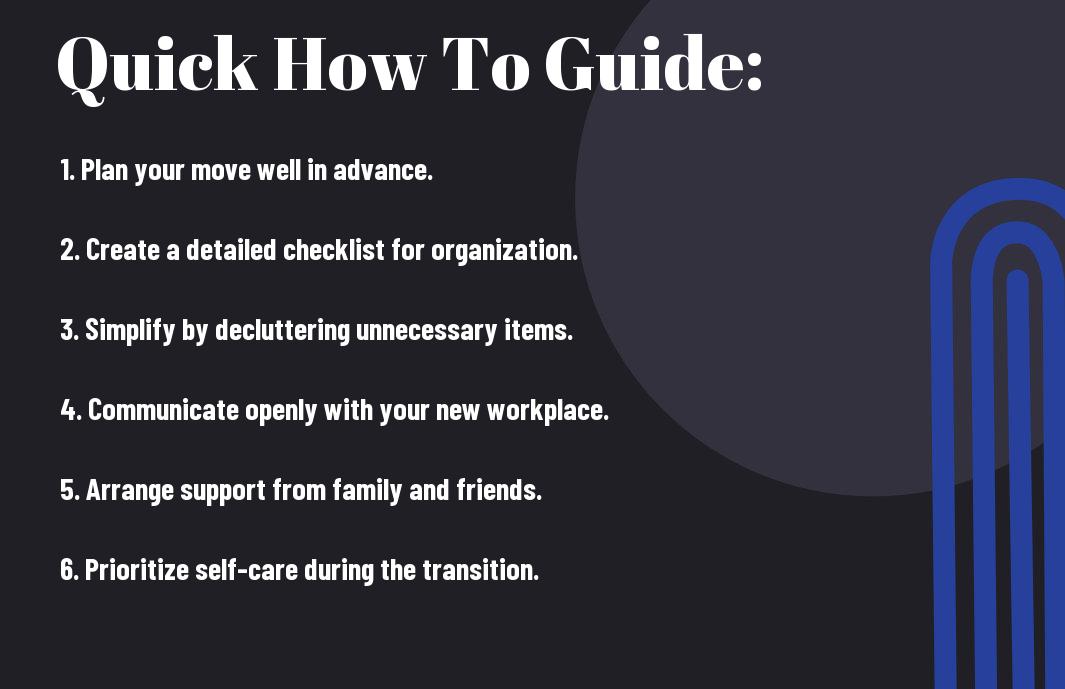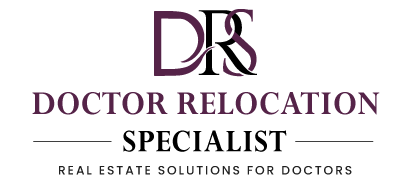Over the years, transitioning into a new role as a medical professional can be both exciting and overwhelming. As you prepare for your move, it’s important to implement effective strategies that will help alleviate stress and ensure a smooth transition. In this post, you will discover expert tips and techniques tailored to your unique needs, allowing you to focus on what truly matters – your career and well-being. Let’s explore how to streamline your move and embrace this new chapter with confidence.
Understanding the Factors of Stress During a Move
The process of moving can be inherently stressful, often due to various factors that come into play. Acknowledging these factors is vital for mitigating stress levels. Some common stress-inducing aspects include:
- Time constraints and deadlines
- Financial implications and budgeting
- Emotional attachments to your current home
- Logistical challenges like packing and transport
Recognizing these factors allows you to take proactive steps in managing stress effectively.
Identifying Common Stressors
Clearly, identifying the stressors specific to your moving situation can empower you to create effective coping strategies. These stressors may vary from personal to professional, impacting how you prepare for and navigate your move.
The Impact of Change on Mental Health
Little do many realize that even positive changes, like a new job, can contribute to anxiety and stress. The psychological effects of transition can manifest in various ways, affecting your overall well-being during and after the move.
Stressors related to moving can lead to feelings of uncertainty and overwhelming emotions. Adapting to a new environment, building new relationships, and adjusting to different work dynamics may exacerbate feelings of anxiety. Understanding that these feelings are common can help you better navigate the challenges ahead, allowing you to prioritize your mental health and seek support when necessary.

Planning Your Move: A Step-by-Step Guide
If you want a smooth transition during your medical professional move, detailed planning is key. Begin by breaking your move down into manageable tasks. Use the table below to outline your preparation, ensuring that you stay organized throughout the process.
| Task | Deadline |
|---|---|
| Assess current items | 4 weeks before |
| Hire moving company | 3 weeks before |
| Begin packing non-necessarys | 2 weeks before |
| Confirm utilities at new location | 1 week before |
| Final packing and moving day logistics | Move day |
Creating a Detailed Timeline
If you outline a clear timeline for your move, you reduce the chances of last-minute stress. Start by listing out important dates and tasks to ensure you stay on track as you prepare for your relocation.
Essential Packing Strategies
Now that you have your timeline ready, it’s time to focus on packing efficiently. Implementing a system will make the process more manageable and allow you to locate important items easily during and after your move.
Packing should be approached thoughtfully. Start with rooms you use less frequently and work your way to daily necessarys. Use sturdy boxes and be sure to label each box by contents and destination room, which will simplify unpacking. Consider creating a “first-day” box that includes all necessarys you’ll need immediately. Utilizing color-coded labels can also streamline your unpacking process. Finally, take inventory of your items to create a checklist that ensures nothing goes missing during your move.
Tips for Managing Time Effectively
To minimize stress during your medical professional move, it’s vital to manage your time effectively. Here are some strategies to help you stay organized:
- Set clear deadlines for each task.
- Break larger tasks into smaller, manageable steps.
- Avoid multitasking; focus on one task at a time.
- Schedule regular breaks to recharge.
Thou will find your moving experience more manageable when you prioritize your time wisely.
Prioritizing Tasks
Any successful move begins with effective prioritization of your tasks. Start by identifying the most important activities that need to be completed first, such as securing your new work location, setting up utilities, and planning logistics for your moving day. By categorizing your tasks based on urgency and importance, you can ensure that nothing critical is overlooked.
Utilizing Checklists and Schedules
An effective way to stay on track during your move is by utilizing checklists and schedules. These tools can help you visualize your progress and keep you accountable for each step you take.
It can be beneficial to create a detailed checklist outlining every task required for your move, from gathering documents to packing your belongings. Additionally, develop a schedule that allocates specific time slots for each item on your checklist. This strategic approach will not only enhance your productivity but also alleviate the anxiety associated with potential moving disruptions. By having a structured plan, you can confidently approach your move, ensuring that you cover all necessary aspects without feeling overwhelmed.

Finding Support: Building Your Moving Team
Once again, assembling a reliable moving team can significantly alleviate the stress of relocating. Consider who you can count on—friends, family, and colleagues can all lend a hand, whether it’s packing boxes, providing moral support, or even helping during the move. Look for individuals who understand the demands of your profession and can contribute to a smoother transition to your new environment.
Engaging Colleagues and Friends
Any support from your colleagues and friends can make a world of difference during your move. Reach out to them for assistance with logistics or simply to share the emotional burden of transitioning to a new workplace. Having a familiar face during such a pivotal change not only lightens your load but also fosters a sense of camaraderie that can ease anxiety.
Hiring Professional Movers
Any time you are facing a significant move, hiring professional movers can take a substantial weight off your shoulders. While the cost may seem daunting, the expertise and efficiency of professional movers can save you time and reduce stress associated with packing and transporting your belongings. Their experience in handling fragile items, managing logistics, and navigating the complexities of a medical professional relocation can ensure a smoother process overall.
Another benefit of hiring professional movers is their ability to provide tailored services to meet your specific needs. They can offer packing materials, packing assistance, and even unpacking services at your new location, allowing you to focus on settling into your new role. Evaluating different moving companies and reading reviews can help you choose the right team who will ensure your move is executed with care and precision, allowing you to begin on this new chapter with confidence.
Maintaining Your Well-being During the Transition
All aspects of your well-being deserve attention during your medical professional move. As you navigate changes, prioritize your mental, emotional, and physical health by implementing strategies that facilitate a smoother transition. Engaging in self-care practices can help you manage stress effectively, making the adjustment process less overwhelming.
Practicing Stress-Reduction Techniques
Any effective transition requires you to actively practice stress-reduction techniques. Consider incorporating mindfulness meditation, deep-breathing exercises, or yoga into your daily routine to promote calmness. By intentionally setting aside time for these practices, you can better manage anxiety and maintain a positive mindset throughout your move.
Ensuring a Healthy Routine
One important aspect of maintaining your well-being during this transition is ensuring a healthy routine. A balanced routine supports your physical and mental health, providing stability in an otherwise fluctuating environment.
Routine is beneficial because it creates predictability in your hectic schedule, allowing you to cultivate a sense of control. Aim to incorporate regular exercise, balanced meals, and quality sleep into your daily habits. Set aside time for activities you enjoy, as fostering connections with friends or engaging in hobbies can alleviate stress and enhance your overall mood. Establishing a dedicated routine will help you remain focused, enabling you to navigate your moving process with confidence and ease.
Settling In: Making Your New Space Feel Like Home
Not every new environment feels immediately welcoming, but you can make it your own with simple touches. Start by arranging your furniture in a way that feels comfortable and functional. Incorporate personal items, such as photos or decorations that remind you of home, to create a sense of familiarity. Surrounding yourself with things that bring you joy will help transform your new space into a sanctuary where you feel at ease.
Personalizing Your New Environment
Settling into a new space requires you to infuse it with your personality. Choose colors and decor that resonate with your style, whether it’s calming hues or vibrant accents. Add plants to improve air quality and create a lively atmosphere. Your personal touches will help establish a sense of ownership and comfort in your new location, making it uniquely yours.
Establishing a Work-Life Balance
Feel empowered to set boundaries between your professional responsibilities and personal time. Designate certain areas of your home for work to minimize distractions during down time. Scheduling regular breaks and allocating time for activities you enjoy can also contribute to your overall well-being. By creating this balance, you will foster productivity at work while ensuring you nurture your personal life.
Personalizing your approach to work-life balance is vital for overall satisfaction. Consider implementing a routine that includes time for self-care, hobbies, and socializing. Engage in activities that recharge you, whether it’s exercise, reading, or spending time with loved ones. This focus on personal fulfillment will help you maintain the equilibrium necessary for thriving in both your professional and personal spheres, allowing you to adapt to your new environment more effectively.
Final Words
Conclusively, minimizing stress during your medical professional move involves careful planning, efficient organization, and the implementation of practical strategies tailored to your unique needs. By prioritizing tasks, leveraging support systems, and maintaining a positive mindset, you can navigate this transition smoothly. Embrace the opportunity for growth and transformation as you initiate on this new chapter in your career. Your well-being is necessary, so take the time needed to adapt and thrive in your new environment.

